This interesting home is made from earthbags, also known as sandbags. Sandbags were first used by the military and emergency services teams to build protective structures and for flood control. Now the concept of using earthbags has been applied to housing to create strong and affordable earthbag round house. Earthbags are ideal for making homes that will stand up to the harshest weather. And using the right design, you can also have one of the safest homes in a fire zone. Obviously, a grass roof is not going to help there.
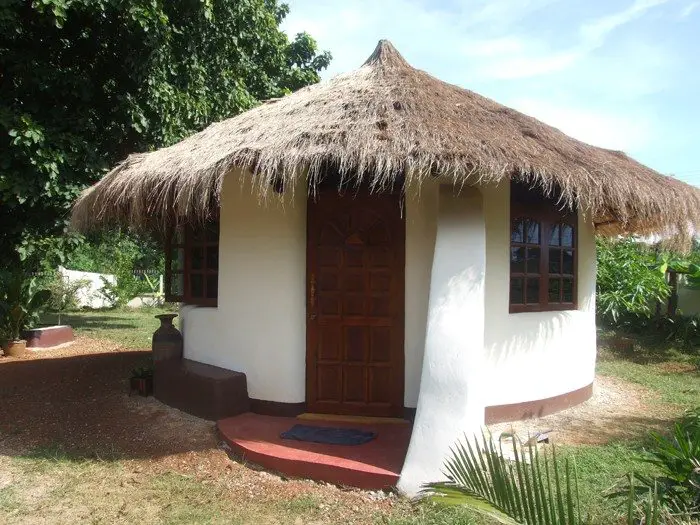
Aside from being durable structures, earthbag homes are also cheap. They are labor-intensive but bags can be filled with either dirt from the property itself, or other available sources and the homes can be built practically anywhere in the world. Aside from saving money, you also get both thermal mass and great sound and temperature insulation.
Click on any image to start the lightbox display. Use your Esc key to close the lightbox. ?

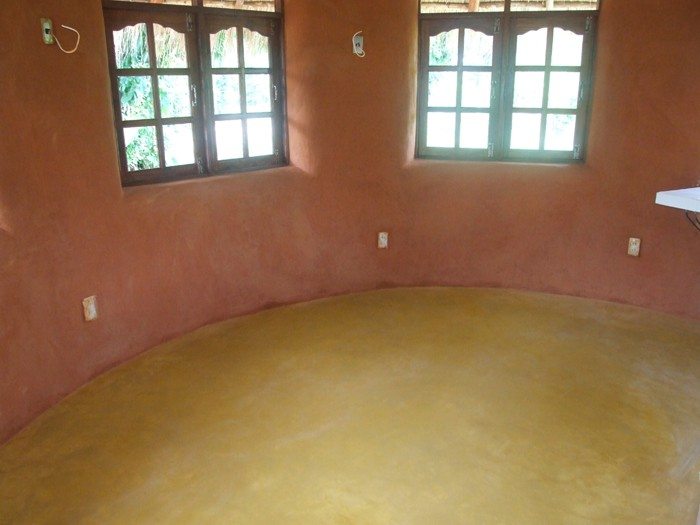
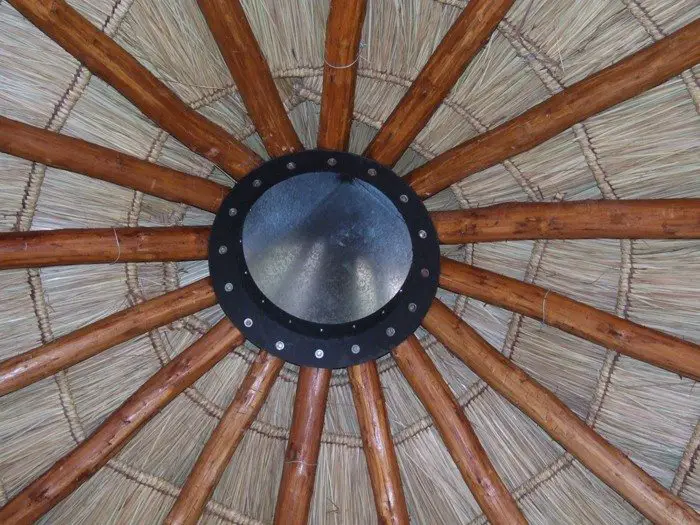
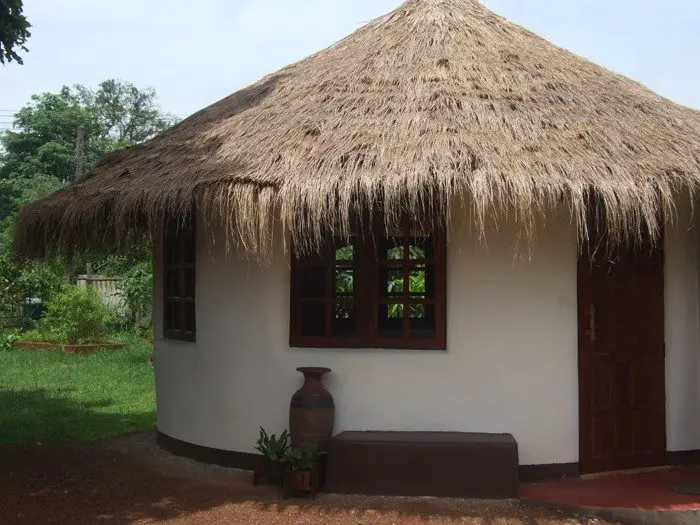
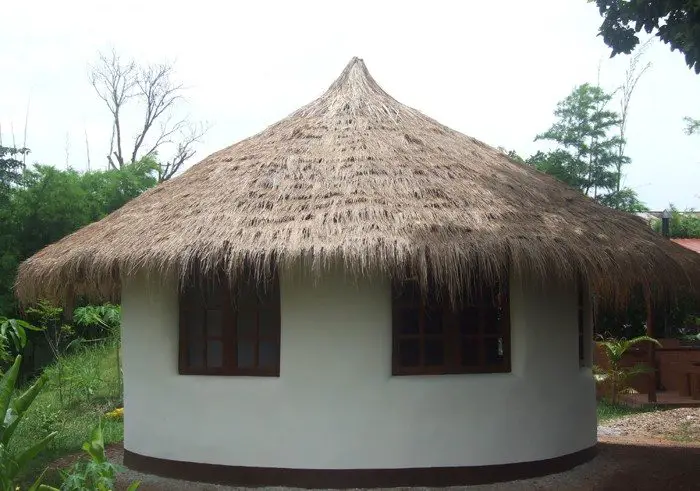
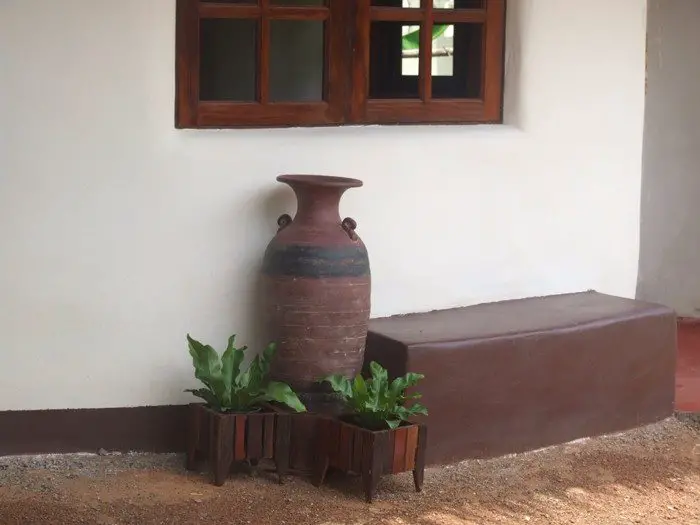
Building an Earthbag Round House
Materials
- Woven Polypropylene Bags (about 18” x 30”)
- Bucket Chute (4-gallon bucket with the bottom cut off)
- Soil
- Gravel
- 4 or 5 heavy-duty 2-gallon Cement Buckets
- 4-point Barbed Wire
- String Line
- Sheet Metal Slider (about 13” x 16”)
- 15 gauge Galvanized Wire
- Bundle 500 Bags
- Concrete or Stones – for door threshold
- Galvanized Nails
- Galvanized Sheet Metal Anchors
- Long Wood Poles
- 2×4 Bucks
- ½” Rebar
- ¼” Plywood
- Hurricane Ties
- Metal Compression Ring
- Thatch
- Screws
- Cement
Tools
- Shovel
- Trowel
- Metal Chisel and Scrap Steel (or Bolt Cutters) – for cutting barbed wire
- Knife
- Wire Cutters
- Tape Measure
- Grub Hoe
- Tampers
- Corner Guide
- Level
- Sledge Hammer
- Hammer
- Cordless Drill
- Sponge Float
Steps
Earthbag foundations – gravel-filled bags or stabilized bags – offer many advantages over reinforced concrete foundations and work well with many types of sustainable earthbag round houses. In particular, they are low-cost, fast, and easy to build, require no cement (a major expense and cause of global climate change), and require no forms or expensive equipment. In cold climates, you can use lava rock or pumice to create an insulated foundation. This one simple step can save you thousands of dollars over building with concrete and cut your energy costs.
Typical earthbag foundations are made with poly bags (double-bagged for strength) filled with gravel. Aggregates are preferred for foundations because they will readily drain away any moisture and prevent wicking into the wall system. Some prefer to use stabilized soil in earthbag foundations, seeing it as a longer-lasting solution. The jury is still out, but it appears poly bags kept out of sunlight can last hundreds of years, so gravel-filled bags should last at least a lifetime.

Simply fill the bags in place for your earthbag round house with gravel. Stitch the ends closed or fold the bag end over. Butt each bag tight against the previous bag. Tamp the bags flat after each course is complete. Add two strands of 4-point barbed wire between each course. Add courses of gravel-filled bags until you’re at least 6” above the risk of moisture damage to your earthbag round house.
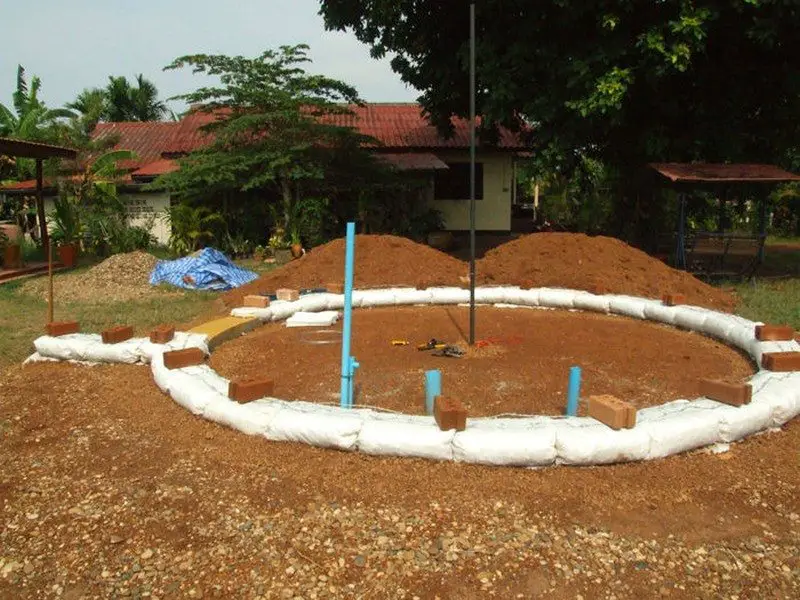
You’ll want durable thresholds at entry doors to your earthbag round house. I recommend concrete or stone for this purpose. In this method, the finished floor height (F.F.) is the same as the threshold. In other words, the threshold and floor will be the same height. To build the threshold this way, pour a 2”-3” concrete threshold, sloped slightly for drainage, on top of the earthbags at each entry door location.
You can add concrete pigment to make it any color you want for your earthbag round house. Allow adequate time for drying (about one week, depending on the temperature), and then set the door back on the threshold and brace securely in position.
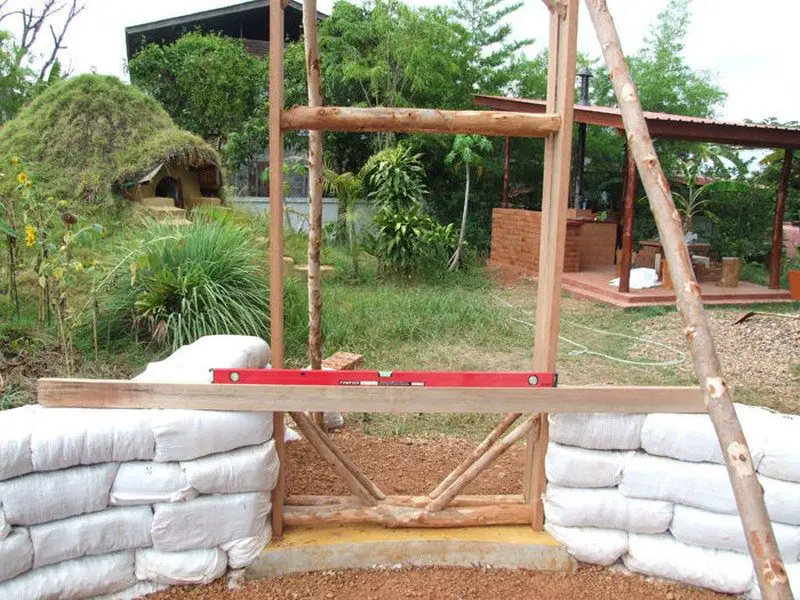
At this point, you can continue stacking courses of bags for the remainder of the earthbag round house walls, but now the bags are filled with soil. Most types of subsoil are suitable for earthbag construction. The subsoil is the clay/aggregate soil that’s below the topsoil. You could dig your own, but you can buy it very inexpensively and save many days of hard work. You can also buy an engineered mix called road base for your earthbag round house, which contains the ideal ratio of clay to aggregates, no mixing required.
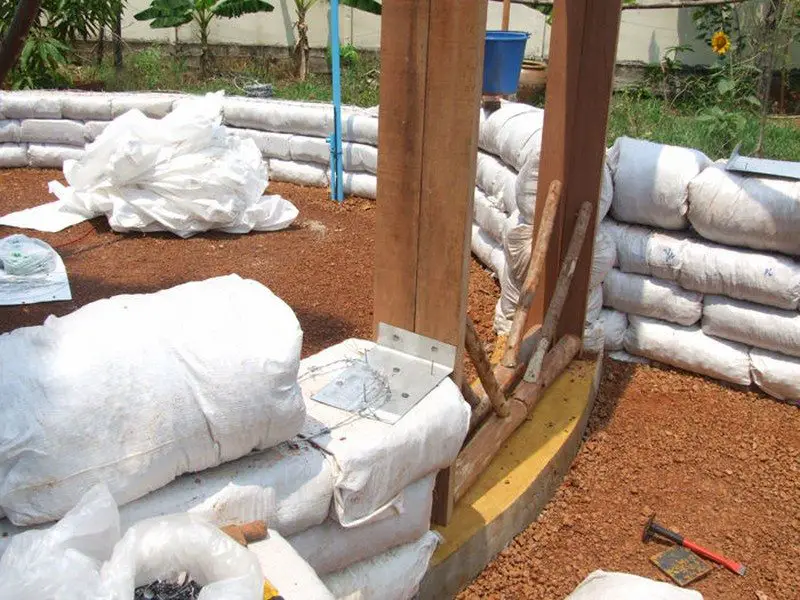
Measure the radius of each course of bags to maintain an accurate circle to your earthbag round house. Tie a piece of rope to the center pole and use it to check the radius of every bag. Always keep the rope level for accurate results.
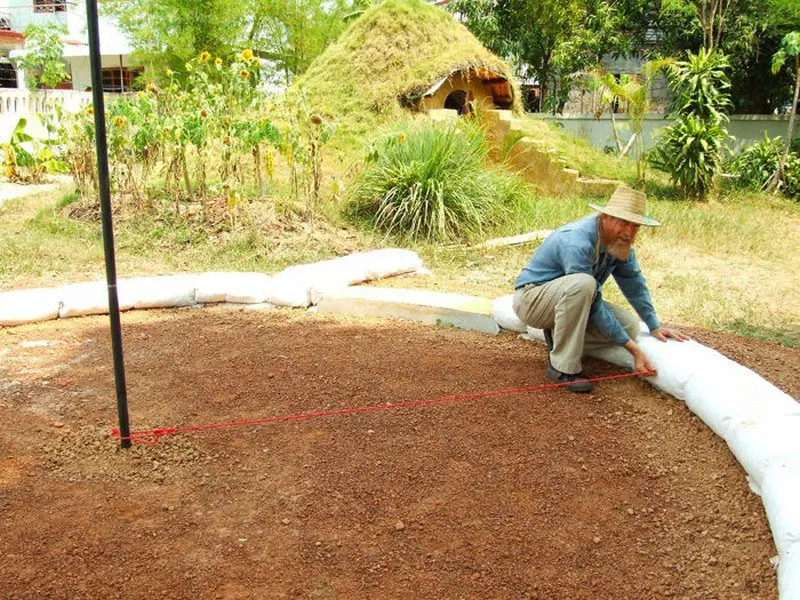
Tamp earthbags solid and level after each course is complete. Tamp the high points first. Then evenly tamp the entire earthbag round house wall several times as you continually move the tamper. This last step avoids creating low spots. And if you use the same number of buckets of soil in each bag, and are carefully placing the bags, the courses are almost self-leveling. Consistency is the key. Use the same process for each bag. Remember to place two strands of 4-point barbed wire between every course.
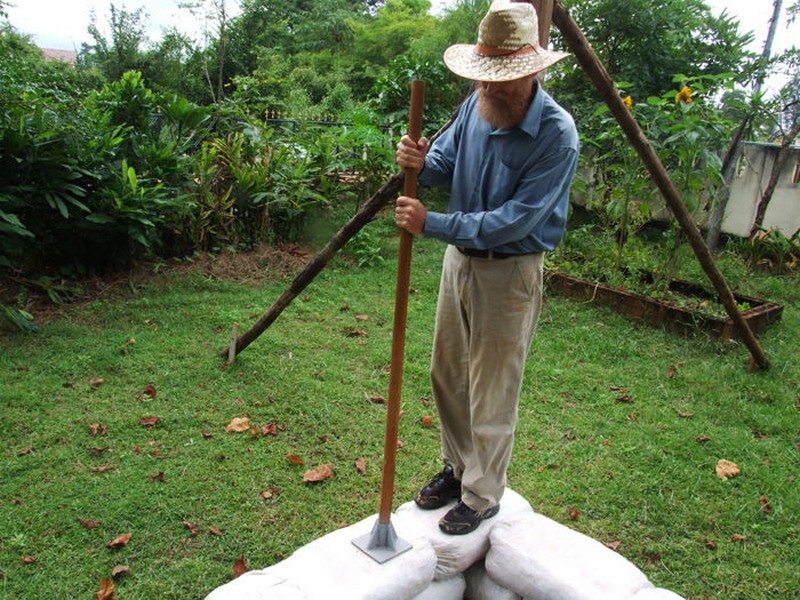
Add metal or wood anchors every few courses to secure the earthbag round house door and window bucks to the earthbags. Most people use wood anchors. But in areas with termites, it’s best to use anchors made of galvanized sheet metal. They’re inexpensive, strong, easy to make from scrap metal, resistant to decay and because they’re thin, they don’t take up space between bags like wood anchors do. In most cases, sheet metal anchors are preferred over wood anchors. Simply nail into the earthbags with galvanized nails and screw into the backside of the bucks.
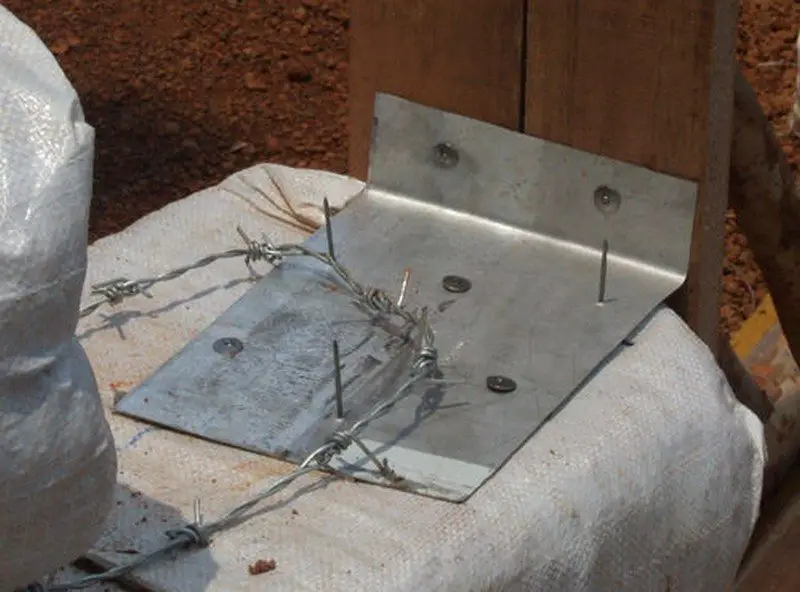
Most earthbag builders use some type of improvised wood or plywood anchor to attach electrical boxes. I’ve found the simplest solution to be 3” wood poles. A rot-resistant variety is best. Embed the poles between courses wherever you want an outlet or switch for your earthbag round house. If you forget or want to add extra boxes, sharpen the end of the pole and drive it into the wall with a small sledgehammer before the soil gets too hard. Use an electrical box as a depth gauge.
You want the front of the box to protrude about 1-1/4” beyond the earthbags to match the plaster. After the walls are built, screw boxes to the stakes with two screws and staple or nail the wiring in the recesses between bags. Complete all the rough electrical work before plastering.
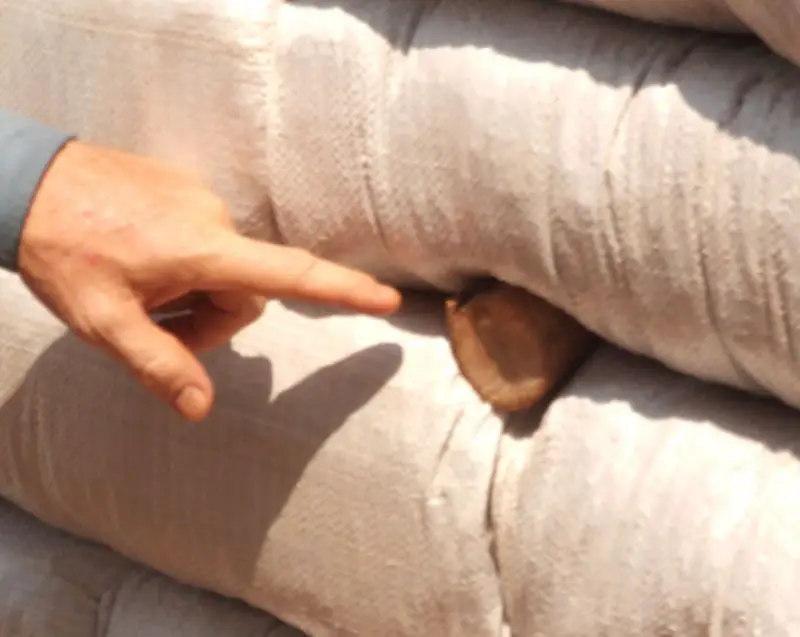
Set window bucks on the earthbag round house wall when you reach windowsill height. You can pre-build the bucks while your threshold is drying. Use standard carpentry techniques to brace the bucks square, and to keep the buck plumb and level. We use double 2×4 bucks instead of wide lumber, and we use poles for braces instead of milled lumber to cut costs. It’s often a good idea to pound ½” rebar down through the bags on either side of door and window openings if you have lots of openings like we do.
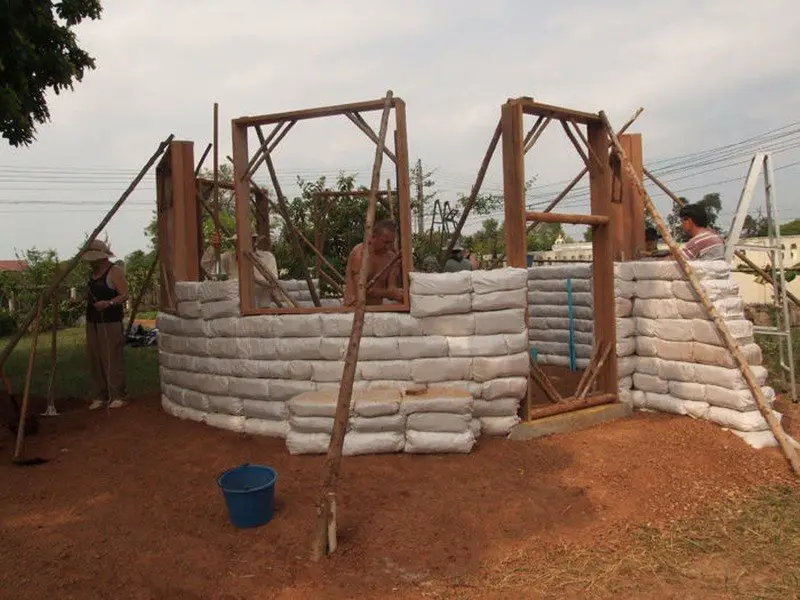
It’s easiest to build a bond beam immediately above the earthbag round house windows and doors so you don’t have to build lintels. This method saves hundreds of dollars and one whole step. Reinforced concrete or wood bond beams are both acceptable. You’ll want to read up on these building steps since the subject is too involved to summarize in a few sentences.
We used concrete due to the prevalence of termites in our area. We used two layers of ¼” plywood as forms, ½” rebar pins pounded in the tops of walls, and ½” horizontal rebar. Pour the concrete nonstop so you don’t have any joints. Embed hurricane ties in the concrete for securing roof poles. Allow drying several days before stripping the forms and building the roof. Any voids in the concrete can be patched when you plaster.
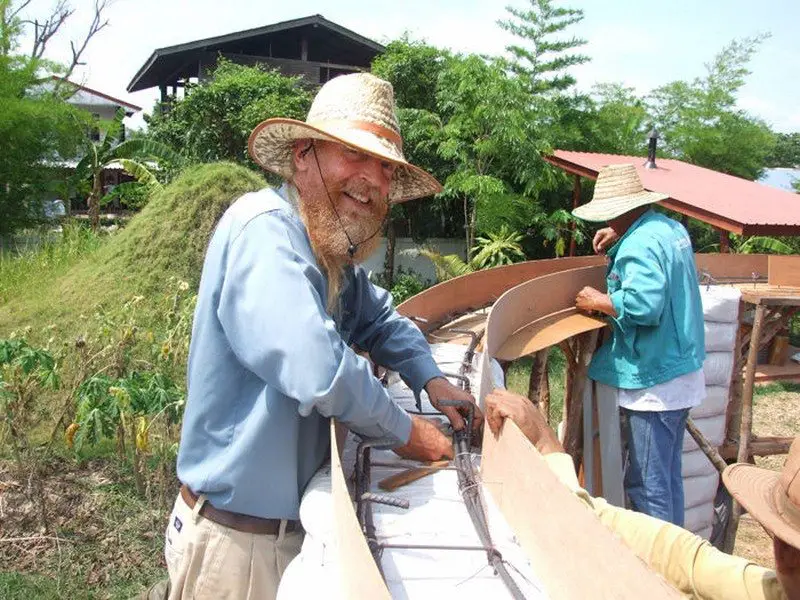
Build the earthbag round house roof after the bond beam is finished. Any type of roof is possible, and space doesn’t allow a lengthy discussion. We used a metal compression ring with radiating wood poles covered in thatch. Create large roof overhangs of approximately 30”-36” to protect walls from moisture damage. The exact size will depend on your climate.
The earthbag round house has a super strong feeling due to the concrete bond beam, thick walls, sturdy poles, and round shape. You could probably have a dozen workers on the roof with no visible effect. The roof frame went together almost like clockwork. The compression ring worked perfectly. The roof was all bolted together in about 4 hours, in part because the poles were precut and prefinished in advance.
Thatching is usually very slow and laborious, but we thatched our earthbag round house in just one day and for only $100 using pre-made thatch panels. That’s why I love thatch panels – they’re very inexpensive and all the tedious work has already been done. And they work great on the round (conical) and organically shaped roofs because they’re flexible. Just bend them into position and nail them in place. We installed the panels using 8″ spacing. Plan on rethatching every 3-5 years or so, depending on the quality of your thatch. Some thatch will last 10 years or even longer.
In cold climates, you’ll want a thick roof with lots of insulation. This can be achieved with trusses or TJIs (engineered truss joists). Wide dimension lumber could also be used, however, this requires cutting the old-growth forest.

Use standard carpentry techniques to install doors and windows. This boils down to simply screwing the door and window frames to the bucks so they are plumb and level. Add shims as necessary. Remove the doors after they are fitted to prevent damage. Mask off windows with plastic to reduce cleanup later.
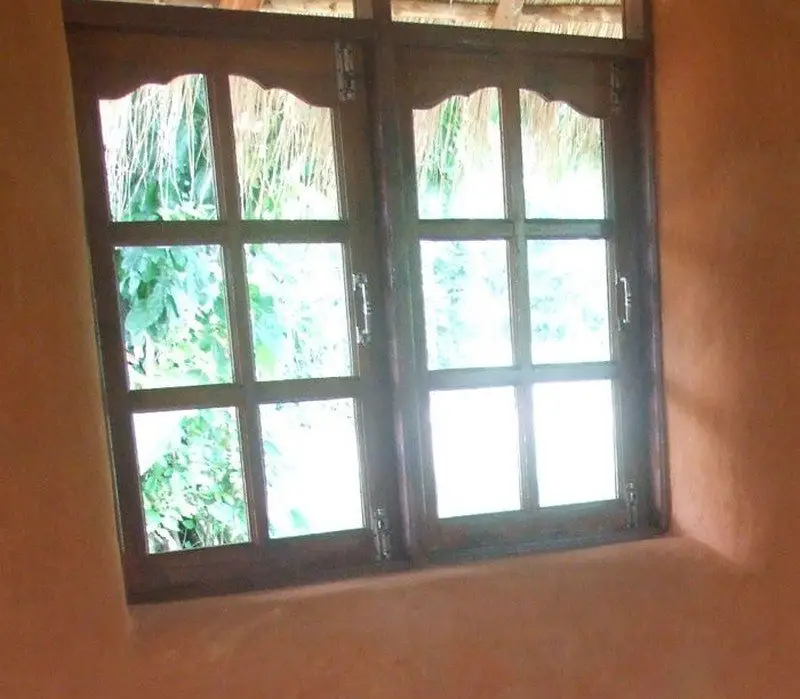
Here’s a summary of the cement plastering process we used on the exterior of our earthbag round house:
Step 1: Put cement between the bags in the recesses.
Step 2: Add a thin coat of cement over bags.
Step 3: Add more cement.
Step 4: Add more cement.
Step 5: Trowel the plaster smooth and use a sponge float to smooth out the finish.
As you can see, the process is quite simple, although labor-intensive. It boils down to adding a little plaster at a time. Leave each coat rough so the next coat will better adhere. No plaster mesh is needed – the plaster sticks to the earthbags, no problem. Resist the temptation to overwork the plaster or you’ll lose adhesion to the bags. The total process took about five days of work for two workers spread out over a little more than a week. A third worker helped the last day. Use best practices in your area. Always prevent the plaster from freezing. Keep plaster moist and allow to dry slowly for best results.
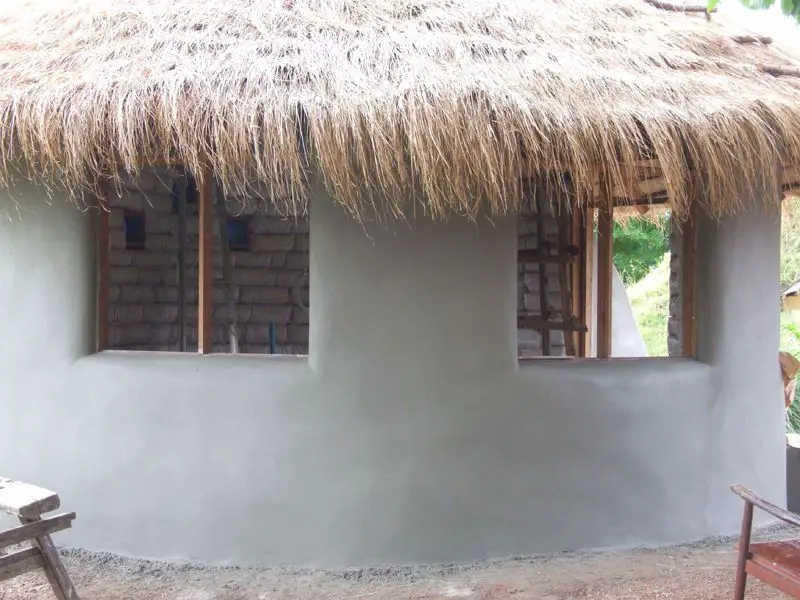
Earthen plaster is the lowest cost, the easiest type of plaster to work with. Many people find earthen plaster very enjoyable work. They’re often pleasantly surprised at how incredibly simple it is. After all, the main process is basically smearing mud on the walls. Follow one of the free recipes on the Internet. Experiment with small patches to help determine the optimum mix for your materials. Add more sand or less water if the plaster cracks. Add more clay if the plaster doesn’t stick to the walls.
The first step is to fill the recesses between bags and apply plaster around doors and windows. Plaster mesh is recommended around all windows and doors to help prevent cracking. You can apply earthen plaster with your hands or with a hawk and trowel. Allow each coat to thoroughly dry before adding additional coats. Leave each coat rough so the next one will more readily bond. Add more coats of plaster until your walls are finished. Smooth the final coat until you’re satisfied with the results.
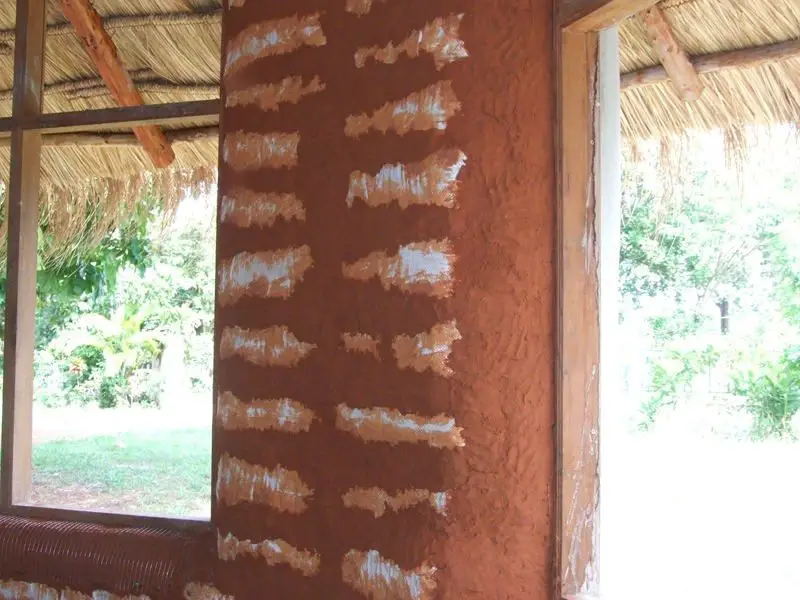

At this point, you can finish your electrical and install plumbing fixtures. You can also install doors, trim, shelving, and cabinets, and then stain and varnish any woodwork, and paint your home. But plastered earthbag walls don’t require painting or trim. Many builders plaster right up to windows, doors, and floors. This is another major time and cost-saving advantage of building with bags.
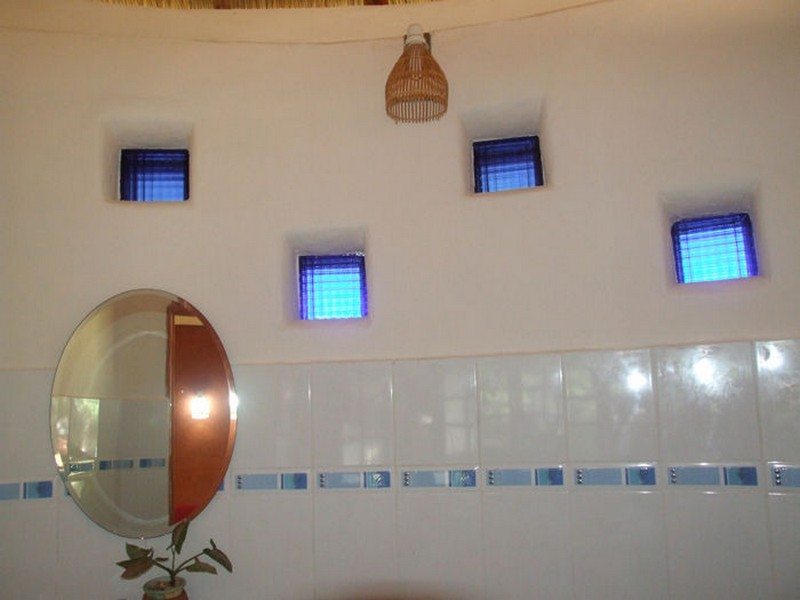
Finishing details turn a earthbag round house into a home. It’s what people really notice. If you want a really nice home, be sure to plan accordingly and give this some extra thought. Finishing work does require extra time and effort, but the results are definitely worthwhile.
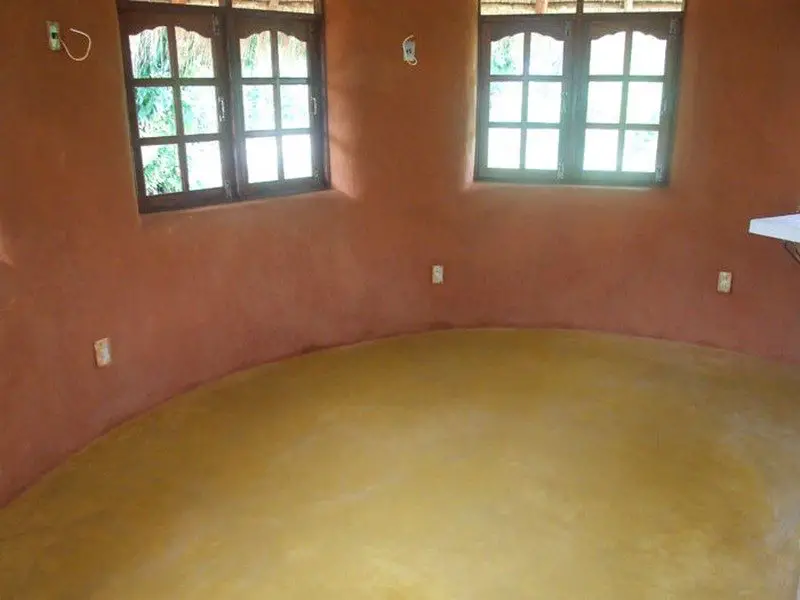
Interior view of our earthbag round house showing the natural color of earthen plaster, recycled windows, and yellow concrete floor. For the floor, we troweled natural iron oxide pigment on the surface before the concrete set up. The pigment is sprinkled by hand and troweled into the top ¼” as the concrete sets up. A little more color was added later during final troweling to even out the color. We were careful to moisten the sand and gravel under the floor to slow drying and prevent cracking.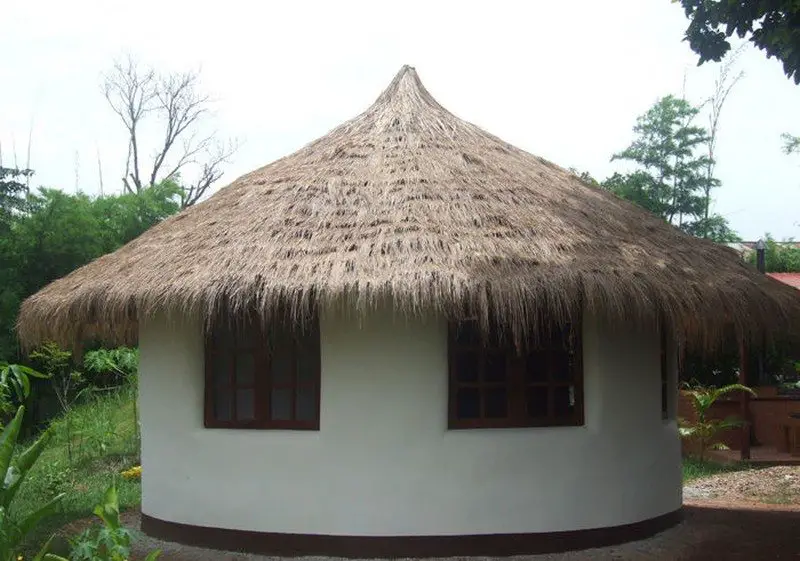 Although made from unusual materials, earthbag round house look good aesthetically. Their fluid, organic shapes blend nicely into the environment. These homes are very easy to personalize to suit the owner’s aesthetic needs.
Although made from unusual materials, earthbag round house look good aesthetically. Their fluid, organic shapes blend nicely into the environment. These homes are very easy to personalize to suit the owner’s aesthetic needs.
Could you live in this earthbag round house?
Thanks to Owen Geiger for this great tutorial!





